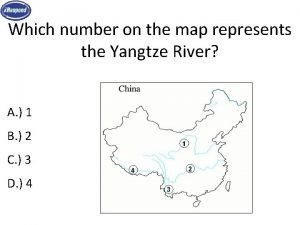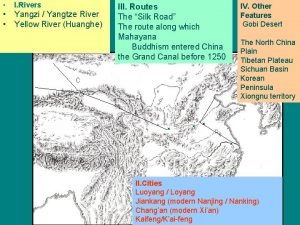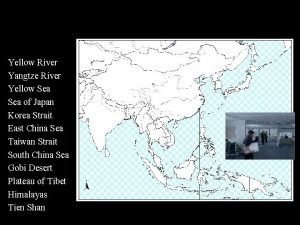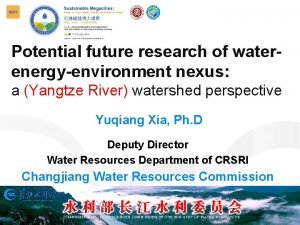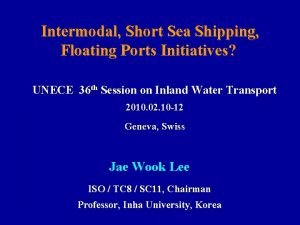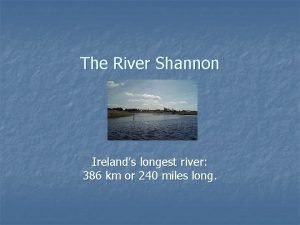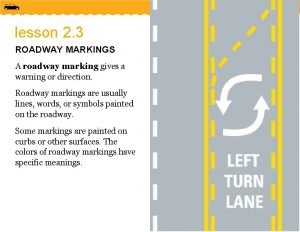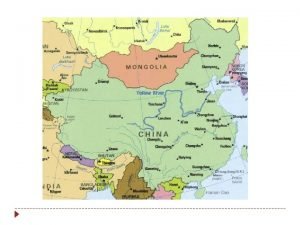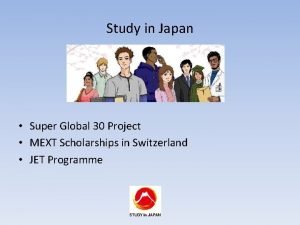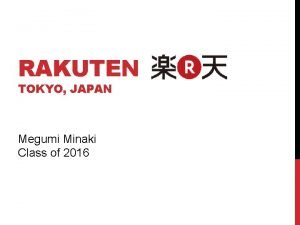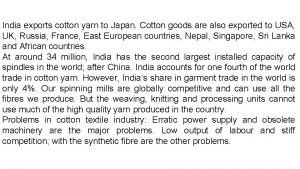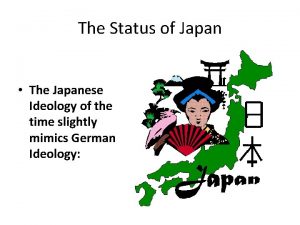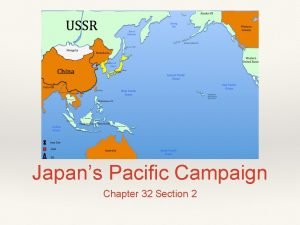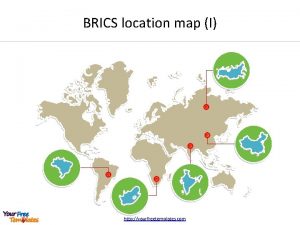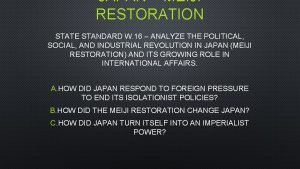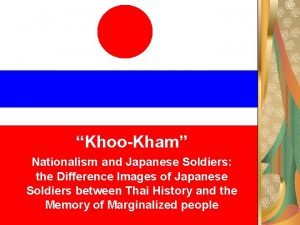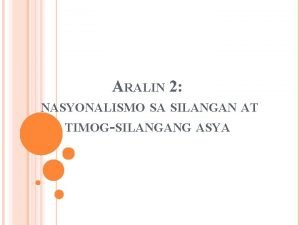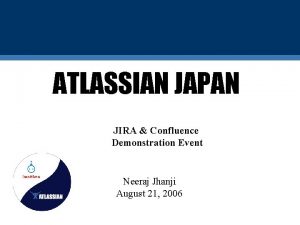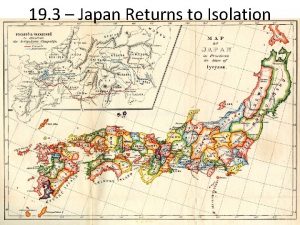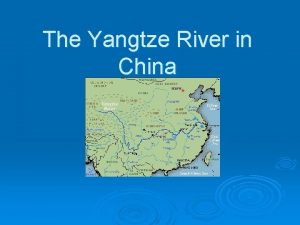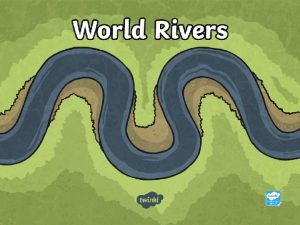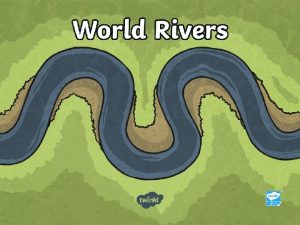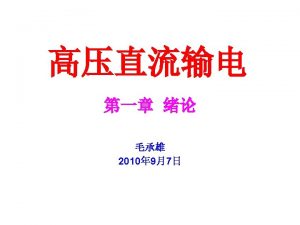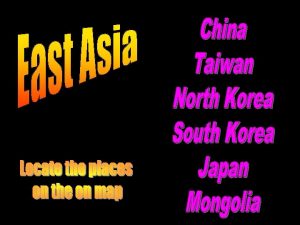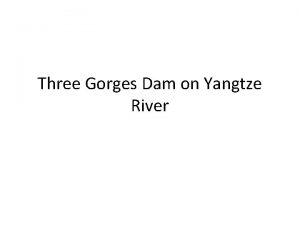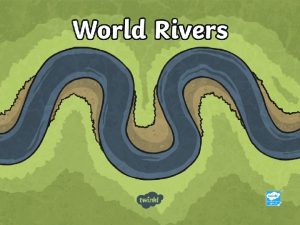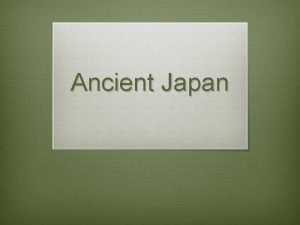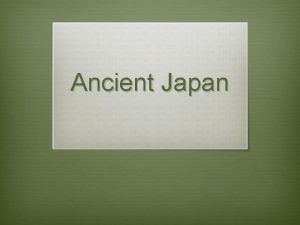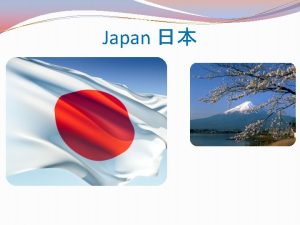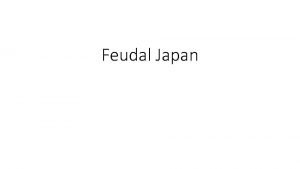Yellow River Yangtze River Yellow Sea of Japan













































- Slides: 45

Yellow River Yangtze River Yellow Sea of Japan Korea Strait East China Sea Taiwan Strait South China Sea Gobi Desert Plateau of Tibet Himalayas Tien Shan

Learning Objectives Learn about the world’s most heavily populated region Understand the sources of cultural cohesiveness in E. Asia Become familiar with the physical, demographic, cultural, political and economic aspects of East Asia Understand the following concepts and models: -Anthropogenic landscape -Confucianism -Marxism -Pollution exporting -Special Economic Zones

Climates

CLIMATE COMPARISON


Japan’s Physical Environment • Subtropical to subarctic • 85% of Japan is mountainous • Seismically active • History of forest conservation • Limited alluvial plains used for intensive agriculture

Japans Core



THE JAKOTA TRIANGLE CHARACTERISTICS Great cities Enormous consumption of raw materials State-of-the-art industries Voluminous exports Global links Trades surpluses Rapid development CHALLENGES Social problems Political uncertainties Vulnerabilities

JAPAN’S CORE AREA

POPULATION COMPARISONS MILLIONS 307 127 49

DECLINING JAPANESE POPULATION Total fertility rates 2. 09 1. 66 1. 65 1. 44 1. 24 0 0. 5 1 1. 5 2

MAJOR GEOGRAPHIC QUALITIES OF EAST ASIA WORLD’S MOST POPULOUS REALM JAKOTA TRIANGLE (JAPAN-SOUTH KOREATAIWAN) LIES AT THE VANGUARD OF PACIFIC RIM DEVELOPMENT POLITICAL AND ECONOMIC FORCES CONTINUE TO TRANSFORM TRADITIONAL CULTURAL LANDSCAPES. INTENSIFYING REGIONAL DISPARITIES POPULATION CONCENTRATIONS IN THE EAST, SITUATED IN RIVER BASINS

KOREA

KOREA The size of “Idaho” but with a population of 74 million Turbulent political history: A dependency of China A colony of Japan’s Divided along the 38 th parallel by Allied Powers > WWII (1945) Cease-fire line established in 1953

NORTH-SOUTH CONTRASTS NORTH KOREA 55% of the land, 1/3 of the population, extremely rural Antiquated state enterprises Inefficient, non-productive agriculture Limited trade – former Soviet Union and China SOUTH KOREA 45% of the land, 2/3 s of the population, highly urbanized Modern factories Intensive, increasingly mechanized agriculture Extensive trade – US, Japan, and Western Europe

SEOUL Capital of Korea (late 1300 s - early 1900 s) 9. 9 million people Located in the northwest corner of South Korea – just south of the DMZ The urban-industrial center! Textiles, clothing, footwear, electronic goods Vulnerabilities?

SEOUL

CLIMATE COMPARISON


ETHNIC GROUPS Han Chinese Zhuang Uygur Hiu Yi Tibetan Miao Manchu Mongol Buyi Korean

ETHNOLINGUISTIC AREAS

LANGUAGES CHINESE IS ONE OF THE WORLD’S OLDEST ACTIVE LANGUAGES. SPOKEN CHINESE VARIES DIALECT TO DIALECT (not mutually intelligible), ALTHOUGH THE CHARACTERS (over 50, 000) USED TO REPRESENT THE LANGUAGE REMAIN THE SAME. SINCE CHINESE IS WRITTEN IN CHARACTERS RATHER THAN BY A PHONETIC ALPHABET, CHINESE WORDS MUST BE TRANSLITERATED SO FOREIGNERS CAN PRONOUNCE THEM.

CHINESE PERSPECTIVES ONE OF THE WORLD’S GREAT CULTURE HEARTHS CONTINUOUS CIVILIZATION FOR OVER 4, 000 YEARS VIEW OF CHINA AS THE CENTER OF THE CIVILIZED WORLD


POPULATION DENSITY

EVIDENCE OF CHINA’S ONE CHILD PROGRAM

China: One-Child Policy Prevented 400 Million Births (AP) BEIJING China's population of 1. 3 billion people would be 400 million higher if not for the government's policy of limiting most families to one child, state media reported Thursday. The "one-child" policy has slowed population growth and contributed positively to the country's socioeconomic development, the Xinhua News Agency said, citing a family planning official. But Zhang Weiqing, the minister in charge of the State Population and Family Planning Commission, said China needed to address the problems of an imbalanced sex ratio and an aging population, the agency reported. The communist government has limited most urban couples to one child and rural couples to two since the 1970 s to try to restrain the growth of China's population and conserve scarce resources. Critics say the policy has led to forced abortions, sterilizations and a dangerously imbalanced sex ratio due to a traditional preference for male heirs, which has prompted countless families to abort female fetuses in hopes of getting boys. Government statistics show that 117 boys are born for every 100 girls in China, well above the average for industrialized countries of between 104 and 107 boys for every 100 girls. Experts have said the gender imbalance resulting from sex-selective abortions and other practices could have dangerous social consequences due to anticipated shortages of marriageable young women. There also concerns about China's aging population, which now exceeds 143 million, Xinhua said. The growing number of elderly will tax China's limited social safety net, especially in rural areas where the bulk of China's population live.

URBAN CHINA 51% URBANIZED ENVIRONMENTAL PROBLEMS AIR POLLUTION CONGESTION WATER POLLUTION

ECONOMIC PROBLEMS SERIOUS ENERGY SHORTAGE TRANSPORTATION INFRASTRUCTURE POORLY DEVELOPED POPULAR RESISTANCE AND CHANGES IN CENTRAL POLICY HAVE WEAKENED CHINA’S POPULATION CONTROL PROGRAM. ENVIRONMENTAL DEGRADATION

ENERGY RESOURCES

Environmental Geography: Resource Pressures in a Crowded Land Flooding, Dam-Building, and Related Issues in China’s Yangtze River is an important resource (3 rd largest by volume) The Three Gorges Controversy World’s largest hydroelectric dam under construction -Purpose: control flooding, generate electricity -Problems: 1. Threatening animal species 2. Flooding a major scenic attraction 3. Displacing up to 2 million people Three Gorges of Yangtze 33



ECONOMIC INITIATIVES “One Country, Two Systems” COMMUNIZISM AND CAPITALISM SPECIAL ECONOMIC ZONES • 5 SEZs ESTABLISHED; 3 IN GUANGDONG PROVINCE (Hong Kong) • INVESTMENT INCENTIVES: LOW TAXES, IMPORT/EXPORT REGULATIONS EASED, LAND LEASES SIMPLIFIED, ETC OPEN CITIES • NATIONAL INVESTMENT FOCUSED ON SHANGHAI OPEN COASTAL AREAS • ALSO DESIGNED TO ATTRACT FOREIGN INVESTMENTS • CONCENTRATED ALONG PACIFIC COAST DELTAS AND PENINSULAS

HONG KONG (SAR) 6 MILLION PEOPLE WITHIN 400 SQ MILES ECONOMY IS LARGER THAN HALF OF THE WORLD’S COUNTRIES 1 JULY 1997 - BRITISH TRANSFERRED CONTROL TO CHINA HONG KONG RENAMED XIANGGANG ACQUIRED A NEW STATUS AS CHINA’S ONLY SPECIAL ADMINISTRATIVE REGION (SAR)

RELIGION

CONFUCIUS CHINA’S MOST INFLUENTIAL PHILOSOPHER AND TEACHER 551 - 479 BC- TOOK ON SPIRITUAL PROPORTIONS AFTER HIS DEATH- CONFUCIANISM EMPHASIZED THAT HUMAN VIRTUES, RATHER THAN GODLY CONNECTIONS, SHOULD DETERMINE A PERSON’S PLACE IN SOCIETY TEACHINGS HAVE DOMINATED CHINESE LIFE AND THOUGHT FOR MORE THAN 20 CENTURIES

Religious Unity and Diversity in East Asia Mahayana Buddhism • Diffused to China from India by the second century A. D. s Widespread throughout the region Shinto • Closely bound to Japanese nationality • Based on harmony of nature (animism) and its connection to humans Taoism and Other Chinese Belief Systems • Rooted in nature worship • Related to: feng shui; Chinese and Korean practice of designing buildings in accordance with spiritual powers that supposedly flow through the local topography 40


Religious Unity and Diversity in East Asia (cont. ) Minority Religions • Christianity: Less than 1% in China and Japan, but this equals millions; about 6 million in Korea, mostly Protestants • Islam: Several tens of millions of Muslims in China Secularism in East Asia • Confucianism (a philosophy) and Marxism support secularism • East Asia is one of the most secular regions in the world Buddhist temple in Yunnan Province, China 42

TAIWAN

TAIWAN Historical background: A Chinese province for centuries Colonized by Japan in 1895 Returned to China > WWII 1949 – Chinese Nationalists (supported by the US) fled from the mainland established the Republic of China (ROC) Territory - approximately 14, 000 Square miles Population – 23. 7 million 77% urbanized

 Which number on the map shows the yangtze river?
Which number on the map shows the yangtze river? Yangtze river dolphin
Yangtze river dolphin Yangtze river dartford
Yangtze river dartford Yellow sea and east china sea
Yellow sea and east china sea I rivers
I rivers The jakota triangle
The jakota triangle Xinglongwa
Xinglongwa Yangtze dundee
Yangtze dundee Yangtze
Yangtze Marlin symbolism
Marlin symbolism Sea stack sea arch
Sea stack sea arch Led soldiers across hellespont into anatolia
Led soldiers across hellespont into anatolia Hydra coral
Hydra coral Yellow sea
Yellow sea River shannon ireland map
River shannon ireland map River to sea tpo
River to sea tpo Over the mountains and the sea your river
Over the mountains and the sea your river Special roadway markings
Special roadway markings Shared center lane
Shared center lane Ancient river valley civilizations map
Ancient river valley civilizations map Shang yellow river
Shang yellow river The leaves are little yellow fish
The leaves are little yellow fish Wheres the tigris river
Wheres the tigris river Green river (duwamish river tributary)
Green river (duwamish river tributary) I am the river and the river is me
I am the river and the river is me Global 30 japan
Global 30 japan Professional engineer japan
Professional engineer japan Internet only bank
Internet only bank Rakuten internship japan
Rakuten internship japan Nuemberg laws
Nuemberg laws India export yarn to japan
India export yarn to japan Hitler clicker
Hitler clicker Japan 1450-1750
Japan 1450-1750 Ikeuchi japan
Ikeuchi japan Natural pictures
Natural pictures He is from japan
He is from japan Japan ideology
Japan ideology Chapter 32 section 2
Chapter 32 section 2 Yourfreetemplates
Yourfreetemplates Why did japan turn itself into an imperialist power?
Why did japan turn itself into an imperialist power? Japan
Japan Ano ang bahaging ginampan ni emperador mutsuhito sa japan?
Ano ang bahaging ginampan ni emperador mutsuhito sa japan? Philosophy of education in japan
Philosophy of education in japan Jira japan
Jira japan National metrology institute of japan
National metrology institute of japan Japan returns to isolation
Japan returns to isolation
